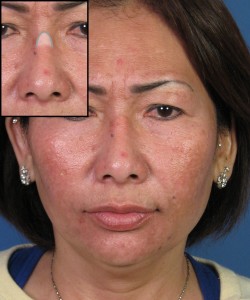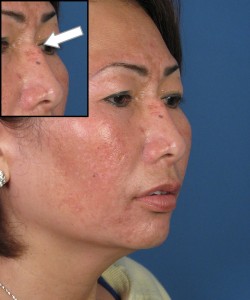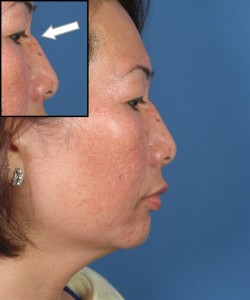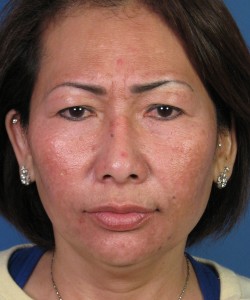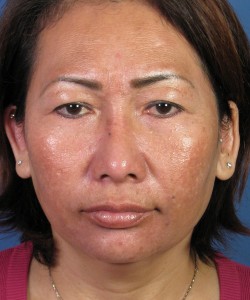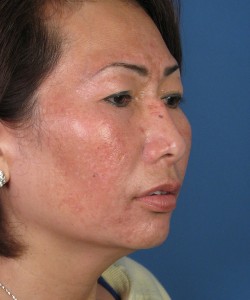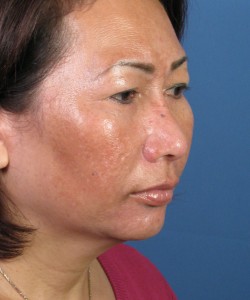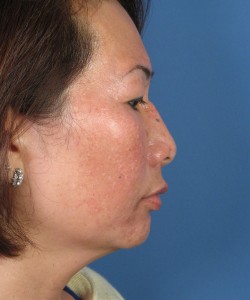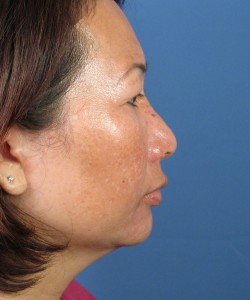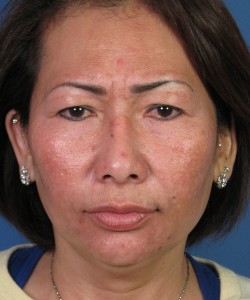 This is a great case example of why I do not like using silicone nasal implants in Asian rhinoplasty patients. This particular Asian patient originally desired to have her nose reshaped for cosmetic reasons to provide a higher bridge and improved tip definition. Unfortunately, her original cosmetic nose surgeon chose to use a solid silicone nasal implant for reshaping, which resulted in a less than desirable outcome. She then consulted with our office to have a revision rhinoplasty performed to help restore a more natural overall shape and appearance.
This is a great case example of why I do not like using silicone nasal implants in Asian rhinoplasty patients. This particular Asian patient originally desired to have her nose reshaped for cosmetic reasons to provide a higher bridge and improved tip definition. Unfortunately, her original cosmetic nose surgeon chose to use a solid silicone nasal implant for reshaping, which resulted in a less than desirable outcome. She then consulted with our office to have a revision rhinoplasty performed to help restore a more natural overall shape and appearance.
Nasal Silicone Implants
So what is a silicone implant? Solid silicone nasal implants are also commonly referred to as silastic nasal implants (combining the terms silicone and plastic). ![]() They are frequently placed by rhinoplasty surgeons to augment the nasal bridge height with or without providing more projection of the nasal tip. Silicone nasal implants are considerably more popular in the Asian rhinoplasty population given the fact that Asian noses typically have an insufficient amount of native cartilage support to provide even moderate definition. For many rhinoplasty surgeons, choosing a silicone nasal implant is an easy option that helps them avoid having to perform more complex rhinoplasty technique. An example of a silicone nasal implant is shown here in the adjacent photo to give you a better idea of what these particular nasal implants look like. As you can see, they are generally shaped like an “L” with the elbow (or angle) of the implant corresponding to the region of the nasal tip. The longer segment of the implant corresponds to the nasal bridge as shown. When placed inside of the nose (just over the nasal framework and under the skin), this type of silicone implant can help raise the height of the nasal bridge while also giving the nasal tip more definition.
They are frequently placed by rhinoplasty surgeons to augment the nasal bridge height with or without providing more projection of the nasal tip. Silicone nasal implants are considerably more popular in the Asian rhinoplasty population given the fact that Asian noses typically have an insufficient amount of native cartilage support to provide even moderate definition. For many rhinoplasty surgeons, choosing a silicone nasal implant is an easy option that helps them avoid having to perform more complex rhinoplasty technique. An example of a silicone nasal implant is shown here in the adjacent photo to give you a better idea of what these particular nasal implants look like. As you can see, they are generally shaped like an “L” with the elbow (or angle) of the implant corresponding to the region of the nasal tip. The longer segment of the implant corresponds to the nasal bridge as shown. When placed inside of the nose (just over the nasal framework and under the skin), this type of silicone implant can help raise the height of the nasal bridge while also giving the nasal tip more definition.
Problems with Nasal Silicone Implants
One of the main concerns with use of solid silicone nasal implants is that they do not become incorporated into the surrounding tissue of the nose. Instead, a capsule (like a smooth wrapping) is formed by the body around the implant. This encapsulation process by the body is an attempt to keep the nasal implant in place. Unfortunately, while encapsulation can keep the implant in the general vicinity, it does not prevent the implant from moving around during the healing process of rhinoplasty. When this occurs, the displaced silicone implant can result in an undesirable cosmetic appearance. In other cases, the silicone implant is outright rejected by the body and can even be pushed out through the skin.
Asian Rhinoplasty – Nasal Silicone Implant
This particular Asian rhinoplasty patient presented to our office complaining that her previously placed silicone nasal implant (done by a different plastic surgeon) had moved. It was now causing an undesirable cosmetic appearance. As you can see in the photos below, the implant was contributing to an unwanted shadow cast across the upper nasal bridge. This can be seen on her frontal view as indicated by the shaded gray curve corresponding to where the upper edge of the silicone implant stopped. Early after her original rhinoplasty surgery, this area looked fine according to the patient. However, a year or so later the implant began to move resulting in this abnormal contour. On her oblique (45 degree angle) view, the white arrow highlights the same abnormal bump caused by the edge of the silicone nasal implant. And on her profile view, the white arrow is almost unnecessary, as the abnormal bump can be easily seen near the top of her nasal bridge. Overall, the displaced silicone nasal implant resulted in a nose that had obvious signs of prior rhinoplasty reshaping.
Asian Revision Rhinoplasty
This particular patient simply wanted to have a nose that looked more natural on her face without the stigma of having had prior cosmetic nose work done. During her consultation with us in our San Diego office, we discussed in detail the recommended changes to her nose. We specifically talked about removing the nasal implant and reshaping the nose in a more natural manner. That is ultimately what she chose to have done. Her surgery was performed in our own accredited ambulatory surgery center under a general anesthetic using an open revision rhinoplasty approach. The previously placed silicone implant was removed and the upper bridge was reshaped to provide her with a smoother profile. At the same time, the nasal tip had to be reshaped once the silicone implant was moved away from this area.
Her before and after revision rhinoplasty photos are shown here.
On her frontal view, you can see that the irregular shadow across the upper bridge is now gone. Her frontal appearance is now much smoother along both sides of the bridge extending from the brow region all the way down to the nasal tip. On her oblique view, you can see that the previously noted bump is now gone – replaced by a more continuous bridge outline. And on the profile view, you can really appreciate the improvements noted in the bridge area. No longer is there an unusual drop off, or step off, from the displaced silicone nasal implant. Now her profile looks much more natural and consistent with most Asian noses you see in public. And if you look closely at her nasal tip, there is a natural looking convexity (roundness) to the tip despite having to remove the nasal implant and replace it with cartilage grafting.
Asian Revision Rhinoplasty Consult in San Diego, CA
Learn more about possible cosmetic revision Asian rhinoplasty by contacting our San Diego office today to consult with revision rhinoplasty and ethnic rhinoplasty expert, Dr. John Hilinski.

